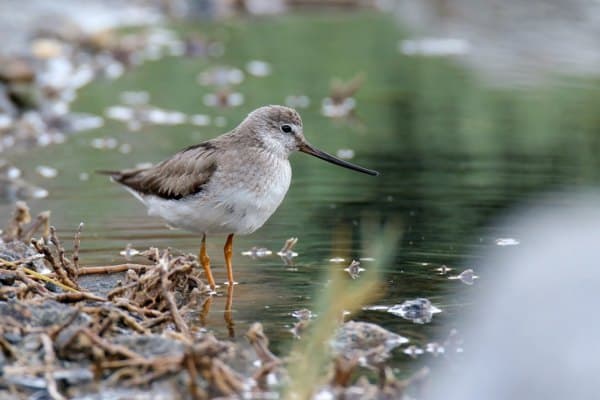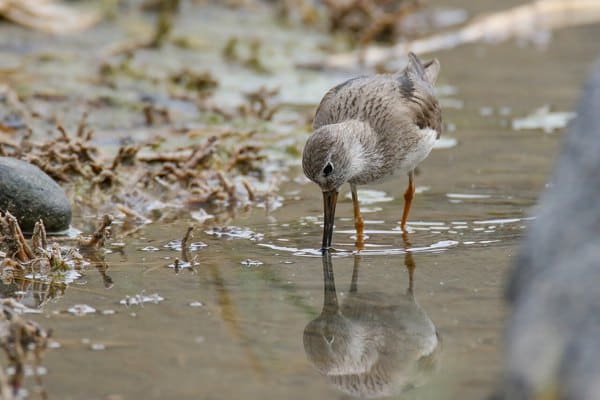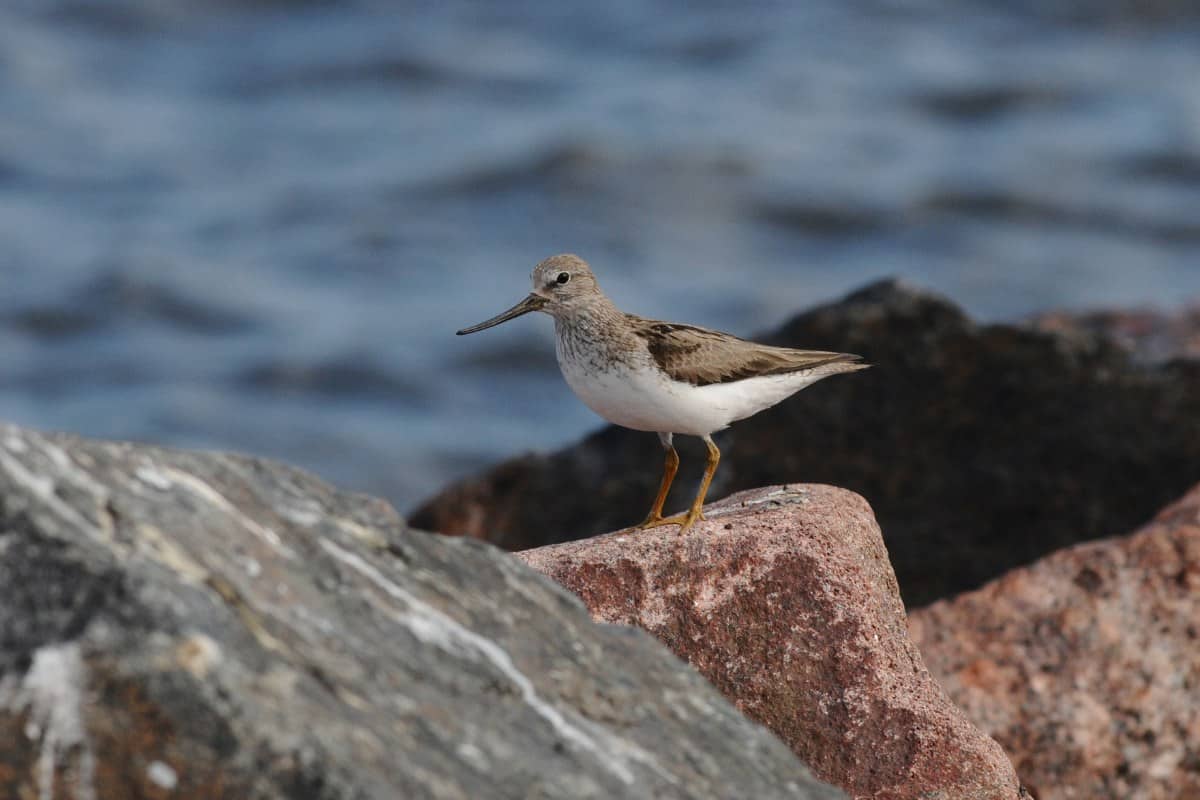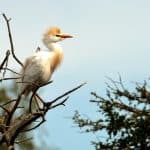Common Name: Terek Sandpiper
Scientific Name: (Xenus cinereus)| Size | Diet | Range in Hawaii | Status in Hawaii |
|---|---|---|---|
| 8 in. - 10 in. | crustaceans, mollusks, and various aquatic insects | O'ahu | Least Concern |
The Terek Sandpiper, also known as Xenus cinereus, is a small shorebird species that is native to the wetlands of Europe and Asia. While the species is not native to Hawaii, it has been known to occasionally visit the islands as a non-breeding visitor and vagrant. With its unique appearance and distinctive behavior, the Terek Sandpiper is a fascinating bird species that has captured the attention of birdwatchers and avian enthusiasts around the world.
In this article, we will explore the world of the Terek Sandpiper, its unique characteristics, and its occasional presence in Hawaii.
Terek Sandpiper
Appearance

The Terek Sandpiper is a graceful shorebird with distinctive features. It measures approximately 8 to 10 inches (20 to 25 centimeters) in length, making it a relatively small bird. Its striking appearance includes a long, slender bill that curves slightly upwards, ideal for probing into the sand and mud in search of prey.
The Terek Sandpiper showcases a striking contrast of black and white plumage, with a white belly and black markings on its wings and back. During the breeding season, it develops a rich rufous or chestnut-colored patch on its crown and neck, adding to its overall elegance.
Diet
The Terek Sandpiper boasts a fascinating and specialized diet perfectly suited to its coastal lifestyle. These dainty shorebirds primarily feast on a menu of small invertebrates found in intertidal zones. Their dining preferences include tiny crustaceans, mollusks, and various aquatic insects.
Nesting
These shorebirds are known for their well-concealed nests, typically situated in shallow depressions on sandy or gravelly shores. What’s remarkable is their choice of nesting sites, often near the edges of saltwater lagoons or along riverbanks. This strategic placement allows them to be close to their primary food source—small invertebrates found in intertidal zones.
Terek Sandpipers are protective parents, diligently guarding their nest sites from potential threats. They skillfully camouflage their nests with surrounding pebbles and shells, making them nearly invisible to predators.
The female typically lays a clutch of eggs, which are well-camouflaged and blend seamlessly with the sandy surroundings. Both parents share the responsibility of incubating the eggs and caring for the young after they hatch.
Behavior

One of their most intriguing behaviors is their agile foraging style. Terek Sandpipers deftly probe the sand and mud with their long, slender bills. This precision hunting method allows them to uncover hidden prey with remarkable efficiency, showcasing their adaptability to intertidal zones.
These sandpipers are also known for their agile flight, which they use not only for hunting but also during migration. They embark on long journeys, flying across continents to reach their breeding and wintering grounds. Their remarkable endurance and navigational skills make them marvels of avian migration.
During the breeding season, Terek Sandpipers engage in courtship displays, including aerial acrobatics and calls, to attract potential mates. Their graceful and synchronized performances add a touch of elegance to the coastal landscape.
Habitat
The habitat of the Terek Sandpiper is a mesmerizing tapestry of coastal environments. These elegant shorebirds are often found in a range of wetland and shoreline habitats along their migratory routes.
Their preferred habitats include mudflats, sandy beaches, saltwater lagoons, and estuaries. These dynamic coastal ecosystems are teeming with their favorite prey—small invertebrates found in intertidal zones.
Range

The Terek Sandpiper is an infrequent visitor to Hawaii, primarily sighted in the Southeastern Hawaiian Islands. This shorebird breeds in Russia and migrates to the Southern Hemisphere. A single record exists from O’ahu, Hawaii, making it a rare find in the region, acknowledged by the Hawaiian Bird Records Committee in 2014.
Conservation Status
According to the recent assessment on the IUCN Red List, the Terek Sandpiper is now categorized as “Least Concern.” This designation suggests that, based on the available data, the species is not currently facing imminent threats or significant population declines.
Interesting Facts
1. Unique name origin
The name “Terek” is derived from the Terek River in the Caucasus region of Russia, where the species was first scientifically described. However, they are not limited to this area and have a much broader range.
2. Juvenile plumage
Juvenile Terek Sandpipers have a distinct appearance, featuring a scaly pattern on their upperparts. As they mature, they gradually develop the adult plumage.
3. Fast feeding
Terek Sandpipers are known for their quick and agile feeding style. They can rapidly probe the sand or mud multiple times per second, swiftly capturing their prey.
4. Hemispheric connection
The Terek Sandpiper’s migration routes connect continents, highlighting the interconnectedness of ecosystems and the importance of international conservation efforts.
5. Synchronized migration
Terek Sandpipers often join mixed flocks of other shorebirds during migration. This synchronization can provide them with safety in numbers during long and perilous journeys.
Frequently Asked Questions
1. Do Terek Sandpipers have any cultural significance in their breeding or wintering regions?
In some regions, Terek Sandpipers and other shorebirds hold cultural and ecological significance. They may be celebrated in local festivals and play roles in folklore and traditional stories.
2. What is the typical lifespan of a Terek Sandpiper in the wild?
The lifespan of a Terek Sandpiper in the wild can vary, but it is typically several years. Surviving their annual migrations and breeding seasons is essential for their longevity.
3. Are Terek Sandpipers known to hybridize with other shorebird species?
While hybridization with other shorebird species is rare, it can occur in cases where different species share overlapping ranges or migration routes.
4. Can Terek Sandpipers be found in captivity or in avian sanctuaries?
Terek Sandpipers are primarily wild birds and are not commonly found in captivity or avian sanctuaries. Conservation efforts typically focus on preserving their natural habitats.
5. How can I contribute to the conservation of Terek Sandpipers and their habitats?
You can support conservation efforts by participating in citizen science programs, supporting organizations dedicated to shorebird conservation, and advocating for the protection of critical coastal habitats.




